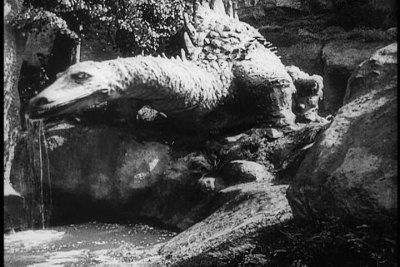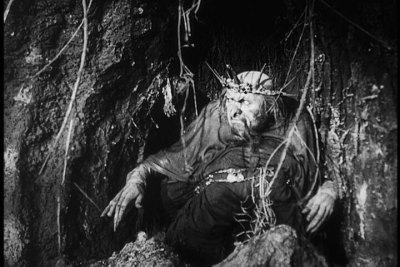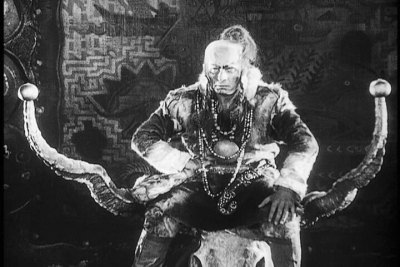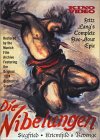| Reviews & Columns |
|
Reviews DVD TV on DVD Blu-ray 4K UHD International DVDs In Theaters Reviews by Studio Video Games Features Collector Series DVDs Easter Egg Database Interviews DVD Talk Radio Feature Articles Columns Anime Talk DVD Savant Horror DVDs The M.O.D. Squad Art House HD Talk Silent DVD
|
DVD Talk Forum |
|
|
| Resources |
|
DVD Price Search Customer Service #'s RCE Info Links |
|
Columns
|
|
|
Die Nibelungen
 Produced over a two year period, and with an amazing 31 week shooting schedule, 1924's Die Nibelungen is a grand movie of epic proportions. Based on a thirteenth century Nordic saga, this film is larger than life. It has a fire breathing dragon, treacherous dwarfs, magic swords, and barbarian attacks. Filled with intrigue and epic quests, this movie was the Lord of the Rings of the silent era.
Produced over a two year period, and with an amazing 31 week shooting schedule, 1924's Die Nibelungen is a grand movie of epic proportions. Based on a thirteenth century Nordic saga, this film is larger than life. It has a fire breathing dragon, treacherous dwarfs, magic swords, and barbarian attacks. Filled with intrigue and epic quests, this movie was the Lord of the Rings of the silent era.
Running at nearly five hours in length, Die Nibelungen is split into two film, Siegfried and Kriemhild's Revenge. But it is really one larger work divided, much like Peter Jackson's Ring trilogy. The film starts with Siegfried, the son of King Sigmund. He has been apprenticed to a sword maker, but has learned everything the master has to teach him. Hearing the a story about the beautiful Kriemhild, brother of King Gunther of Worms, he sets out to win her hand in marriage. On his way through a dark forest, Siegfried encounters a dragon. They fight, and Siegfried defeats the beast. Before he leaves, a bird tells him to bathe in the dragon's blood and he will become invincible. While doing this, a leaf lands on Siegfried's back, leaving one area of skin untouched by the blood, and therefore still vulnerable.
Traveling onwards, Siegfried is attacked by an invisible Nibelungen, Alberich. This dwarf has the a cloak that will the user to become invisible or to assume any shape he wishes. After Siegfried bests him, Alberich promises the hero untold riches if he will only spare his life. Siegfried agrees and gains the magic sword Balmung, and a king's ransom in treasure.
 Meanwhile in Worm, a bard is singing the praises of Siegfried. He tells of his conquest of the dragon, the Nibelungen treasure, and how he has conquered twelve cities. Hearing of his deeds, Kriemhild falls in love with the hero. When Siegfried does arrive at Worm, he meets King Gunther. The King is enraptured by Brunhild of Iceland, a fierce female warrior who will only marry the man who can best her in three contests of strength. To fail to beat her is death. Siegfried promises to help Gunther win his bride if Gunther will allow Siegfried to marry Kriemhild. Gunther agrees and they all set off.
Meanwhile in Worm, a bard is singing the praises of Siegfried. He tells of his conquest of the dragon, the Nibelungen treasure, and how he has conquered twelve cities. Hearing of his deeds, Kriemhild falls in love with the hero. When Siegfried does arrive at Worm, he meets King Gunther. The King is enraptured by Brunhild of Iceland, a fierce female warrior who will only marry the man who can best her in three contests of strength. To fail to beat her is death. Siegfried promises to help Gunther win his bride if Gunther will allow Siegfried to marry Kriemhild. Gunther agrees and they all set off.
Brunhild's castle is surrounded by a moat of fire. Crossing it, they are led in for an audience with Brunhild. She is intrigued by the masculine Siegfried, but is disappointed to find that he is not challenging her, Gunther is. Using his invisibility cloak, Siegfried makes it look like Gunther is the one to out perform Brunhild in the three tasks. Crushed by her defeat, Brunhild agrees to return with him to Worm, where she and Gunther are married along with Siegfried and Kriemhild. Things are looking well, until Brunhild discovers that she was not beaten by Gunther and turns to destroying Siegfried for tricking her.
Note: It is impossible to describe the second film without giving away the ending of the first. If you'd rather not know how Siegfried ends, skip down to the red *end of spoiler* tag below.
*Spoiler Warning*
 At the end of Siegfried, Hagen , King Gunther's aide, kills Siegfried. Kriemhild discovers this, and vows to avenge her murdered husband. The second film, Kriemhild's Revenge, is much less mythical than the first. It has no dragons or magic weapons. It is more grounded, and illustrates how one woman is willing to go to any lengths to get vengeance.
At the end of Siegfried, Hagen , King Gunther's aide, kills Siegfried. Kriemhild discovers this, and vows to avenge her murdered husband. The second film, Kriemhild's Revenge, is much less mythical than the first. It has no dragons or magic weapons. It is more grounded, and illustrates how one woman is willing to go to any lengths to get vengeance.
As the film starts, Kriemhild is still morning her loss. Attila the Hun send an ambassador to propose marriage to Kriemhild. Seeing her chance, she has the envoy swear on oath on his sword that he will avenge any injustice that she suffers.
Fearing that Kriemhild will use the vast treasure that she still has against his people, Hagen steals in and throws it in a lake. When she hears this, Kriemhild realizes who did it. She leaves Worm with the envoy.
After many months of traveling, they arrive at the Hun village. Kriemhild is astonished at how primitive it is. But Attila is enraptured by her beauty, and wants to marry immediately. Kriemhild has a condition: Attila must vow to kill anyone who would treat her wrongly. He does this without hesitation.
Time passes and while out pillaging, Attila learn that Kriemhild has bore him a son. He speeds back and is overjoyed to have an heir. Says he'll grant Kriemhild anything she wishes, and she asks Attila to invite her brothers to come visit her. He does.
After months of traveling, her brothers, arrive with their entourage. When Kriemhild finds out that Hagen is with them, she demands that Attila kill him. He refuses, since they are all guests of his and therefore under his protection. Enraged at this, Kriemhild goes to the Huns themselves, and offers a reward of a shield full of gold to the person who brings her Hagen's head. This sets forces in motion and things soon spin out of control for everyone involved.
*End of Spoilers*
 The full might of the German Ufa studio, which rivaled Hollywood for many years, was behind this production, and you can tell. Every aspect of the production is extraordinary. From the lighting to the costumes to the dazzling special effects, each facet of this movie was carefully crafted to create a mythical world.
The full might of the German Ufa studio, which rivaled Hollywood for many years, was behind this production, and you can tell. Every aspect of the production is extraordinary. From the lighting to the costumes to the dazzling special effects, each facet of this movie was carefully crafted to create a mythical world.
The sets are large in scale, and finely detailed. From the huge mist filled forest to the castle of Worm to the barbarian camp, no expense was spared to make this production look gorgeous.
The cinematography was stunning. Lang blocked the images carefully and almost every shot looks like a photograph. The composition is faultless. The pace, while not fast and furious like today's films, fits the material well. It is more careful and deliberate, but not plodding or slow.
The musical score is preformed by the Munich Radio Orchestra from the original 1924 score composed by Gottfried Huppertz. The music fits in well with the visuals, accenting the drama on the screen. Thought Huppertz did reuse a lot of passages making the score a bit repetitive at times, it is still a superb score.
The best part about this film is that it is entertaining. You can appreciate it for the cinematography or the direction, or on any number of levels. It is an enjoyable movie to watch.
The DVD:
Audio:
The orchestral stereo sound track was reproduced very well. The bass wasn't as forceful as I was hoping it would be, but that's a minor quibble. The sound was clear, though there was some hiss on the soundtrack. On the first disc the hiss is only noticeable at very high volumes and not a problem at all. Curiously enough, it was much higher on the second disc. It varied in level but was noticeable in most sections. The hiss wasn't at a level that made it bothersome, but it was present.
Video:
The video quality is very good for a film that is over 75 years old. This is a restored version, and was pieced together from prints in Germany, Austria and England. While it looked very good, it wasn't perfect. The biggest imperfection was that the whites were a little to bright in some scenes, which led to a loss of detail. There was some slight emulsion damage in one scene, but it was very minor, as was the speckling and dirt. The image is very easy on the eyes. It has a broad range of gray tones and there was excellent detail. You can see the scales on the dragon's hide and even the mist is the forest has a good amount of detail. The bark on the trees and the feathers on Brunhild's helmet are all clearly visible.
This version is not tinted. While there are prints that have tinting in existence, it is believed that Lang did not like the process. The film is not poorer for the lack of tinting at all. A very good looking DVD, with only minor flaws.
The Extras:
On the set with Fritz Lang: A 1 ½ minute excerpt from a German short. It shows Lang working at Ufa and filming a scene. Note the two cameras that are being manually cranked while filming.
Production Design: Five minute reel of production sketches intercut with scenes of the finished product from the movie.
Slaying the Dragon: Information about the most memorable scene in the movie. The section contains the original production design, A photo of Lang filming the sequence, the sequence itself, and a similar scene from Douglas Fairbank's Thief of Baghdad, released the same year, where that star fights a dragon too.
Photo Gallery: Behind the scenes photos with captions. Very interesting pictures.
About the Master: A text piece detailing the origin of the master and the lack of tinting on the print.
Final Thoughts:
Any fan of silent cinema or epic movies should be sure to view this set soon. It is a beautiful film, that is well constructed and entertaining. The DVD comes from a restored print, that, while not perfect, is of a very high quality. Highly recommended.
|
| Popular Reviews |
| Sponsored Links |
|
|
| Sponsored Links |
|
|
| Release List | Reviews | Shop | Newsletter | Forum | DVD Giveaways | Blu-Ray | Advertise |
|
Copyright 2024 DVDTalk.com All Rights Reserved. Legal Info, Privacy Policy, Terms of Use,
Manage Preferences,
Your Privacy Choices | |||||||













